We cut the beech hedging last Monday – the hottest day in the UK for seven years.
I normally cut it in early August but by then there will be a houseful of guests so I thought I’d get the job done now. Wielding heavy petrol cutters and long-reach trimmers was slow, exhausting work in a punishing 34°C. It took three of us a whole day.
The beech is high and it is wide; shaping the arches is especially time-consuming. It involved cutting a bit off, jumping down from the platform, standing well back, looking, judging, climbing back up and taking off a tad more; a process I followed dozens of times.
Here it is afterwards. The new arch is coming along nicely – though it’ll be a few years yet before the saplings on the right catch up. Eventually there will be three arches leading from the car-park into the gardens.
And I’m training yet another arch; this one will be flat-topped and, I hope, will meld into shape next year.
As I had all the hedge-cutting gear out, I tackled the yew hedging too. The new plants in the foreground are struggling a little – it has been fiendishly dry here in Sussex with no rain for several weeks.
At the moment, the strongest scent in the garden is, by far, meadowsweet (Filipendula ulmaria). It continues to colonize the ditches and pond margins and I love it. The smell envelopes you as you approach the west pond and the ditches beyond.
And I like the ribbon of white it forms along the main ditch joining the two ponds.
The so-called ‘flower’ meadow continues to disappoint. It is more of a grass meadow really but knapweed and various vetches are spreading in from the ditch and thankfully
the yellow rattle seed I sowed last December has germinated. I have several patches dotted about the meadow and
I’m now collecting seed from the ‘rattles’ and casting it where I want. (Yellow rattle is a semi-parasite and draws nourishment from the roots of grasses. This reduces the latter’s vigour and so allows flowering plants a chance to grow without being smothered by taller, thicker grass).
It is just as well that I am a patient man. Patient and hopeful; hopeful that in the years to come flowers will continue to grow and spread across the site.
I meant to rejig the long borders last year but did I? I did not. Perhaps this year?
Personally, I would remove the yucca but I do concede that its flowers this year have been impressive.
I’ve added various grasses to the mix to give some extra height. In the background you can see the rose tunnel.
I’m rather pleased with how it is maturing
but there are still gaps where I need to plant four more ‘Sander’s White’ (after much deliberation I have decided that this is the variety that I have inherited – and a fine rambler it is too).
The sheer weight of blossom can be a problem – I sometimes absent-mindedly walk face-first into a sweet-smelling but prickly cushion of white blooms.
The kidney beds (so-called because of their shape) have been fine this past month or so. Though why I persist with that enormous echinops puzzles even me (centre, left-hand bed).
This week I cut back alchemilla, centaurea and hardy geraniums (they should all put on a second flush)
just as day-lilies and Crocosmia lucifer came into flower.
The Campanula lactiflora ‘Pritchard’s Variety’ is over now. I intend splitting this large clump but Mr Kininvie has warned me that this is easily said. I’ll let you know how I get on.
My main crop potatoes (above) were OK this year though the new potatoes were rubbish – I harvested just one bucketful. (I don’t think I watered them enough).
Garlic and onions have been good
and in one greenhouse, I’m beginning to harvest cucumbers
and the tomatoes aren’t far behind. I’m trying a new variety this year called ‘Ukrainian Purple’ (above) as well as ‘Gardener’s Delight’ and four cherry toms in pots.
So no problems in the older of the two ‘houses.
But in the newer one I’ve had a long, bitter and protracted battle with aphids.
They have overwhelmed my aubergines and sweet and hot chillies. I’ve tried rubbing them off, spraying with soap and washing them off with the hose. But during my weekend absences their numbers recovered. Then, one day, I found a ladybird and without really thinking, popped her on an aubergine plant. A few days later a clutch of yellow, conical eggs appeared and a little after that
the larvae hatched. And do you know what?
They are my heroes. I want to draw on my ra-ra skirt, grab my pom-poms and cheer them on. And on. Where I failed, they succeed; effortlessly clearing away the green-fly. How brilliant and very, very satisfying. It is also nice just to have an insect on my side.
So there you go – a quick whizz around the Priory in July.
It’s been a tough month – very, very hot; hedges to cut;
still plenty of compost to cart about as a mulch and endless, dreary watering.
And I haven’t even mentioned the tropical border in this its second year. (It’s doing alright, since you ask. I’ll write a more detailed post about it soon and explain the antirrhinums!).
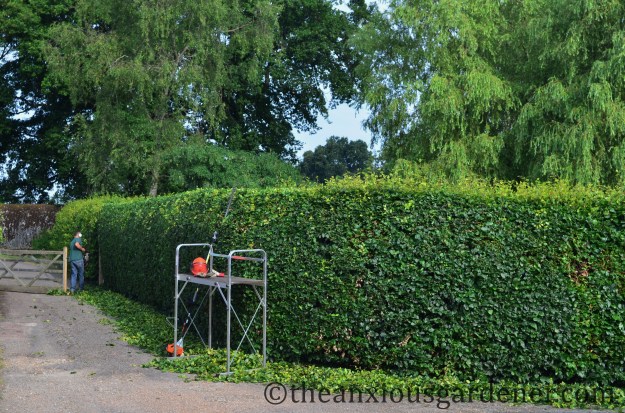

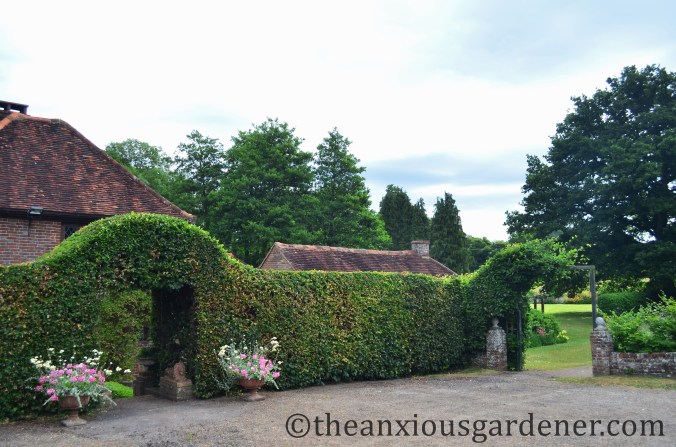
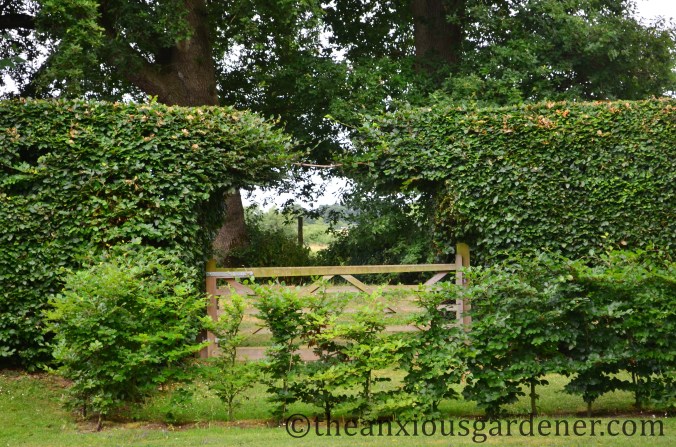
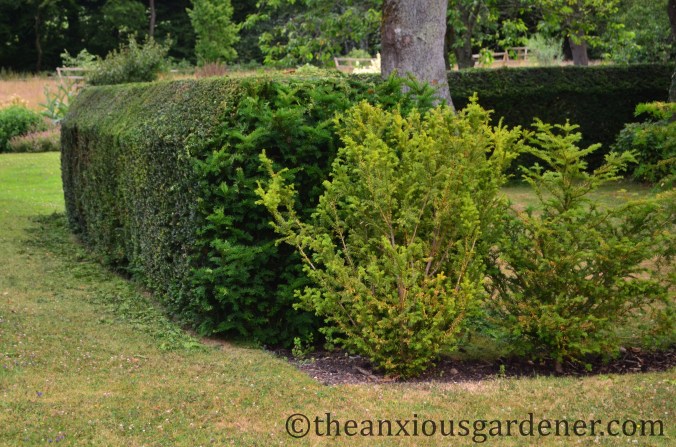


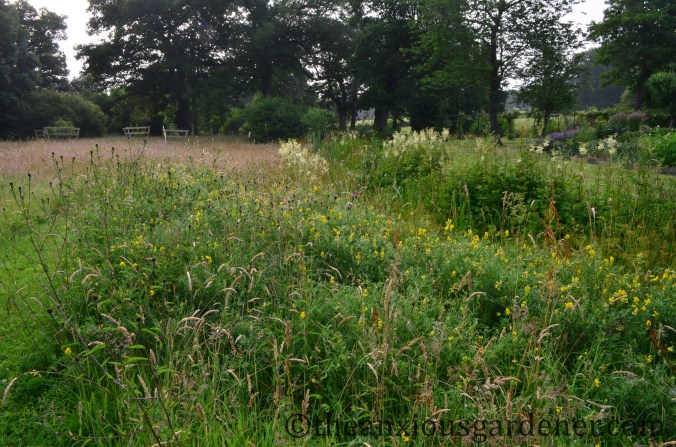



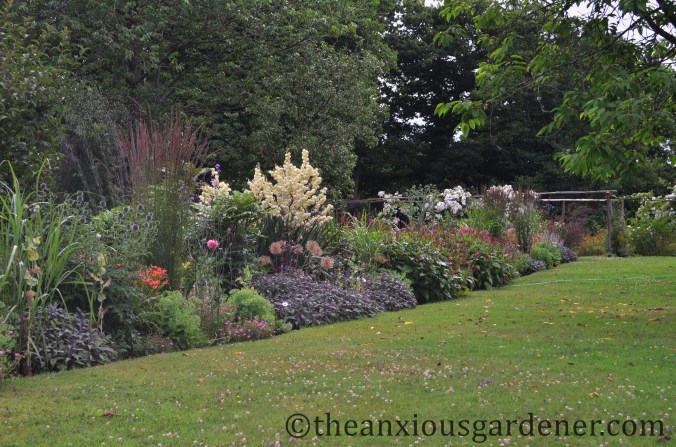
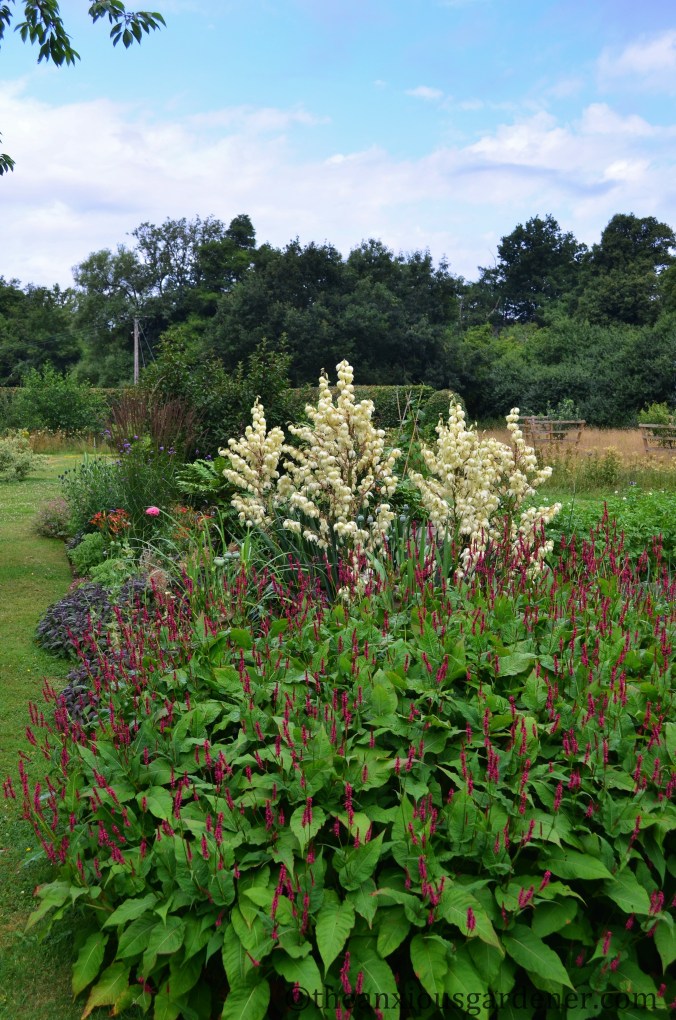


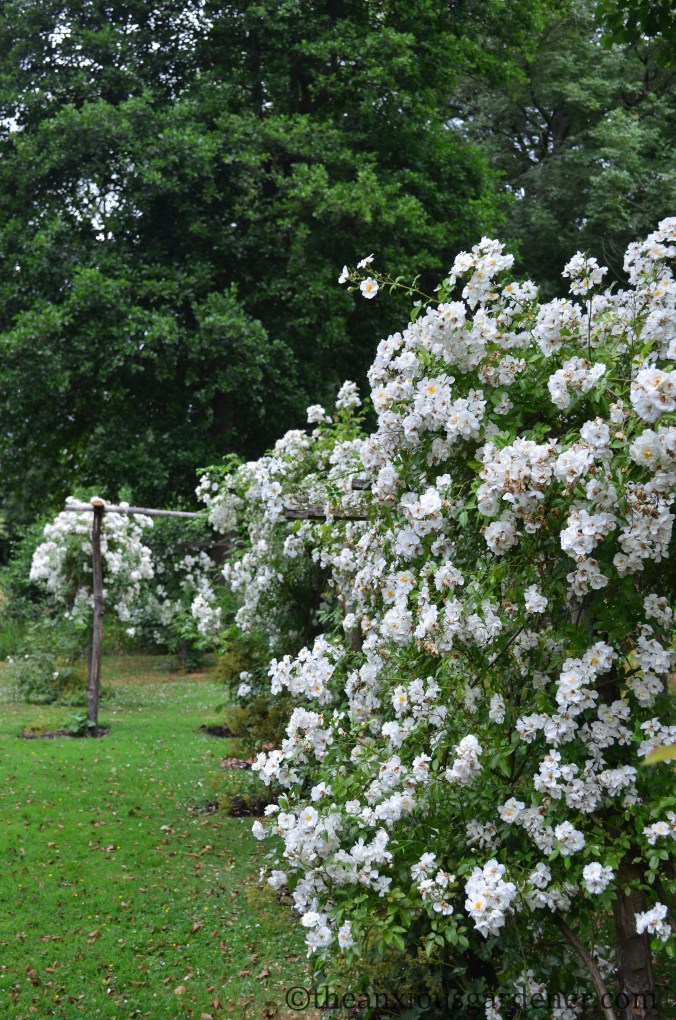




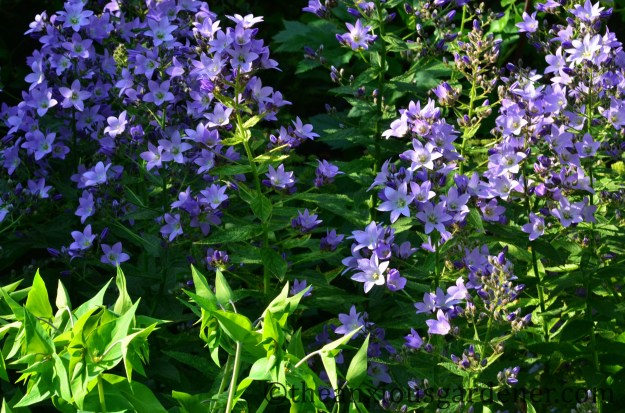
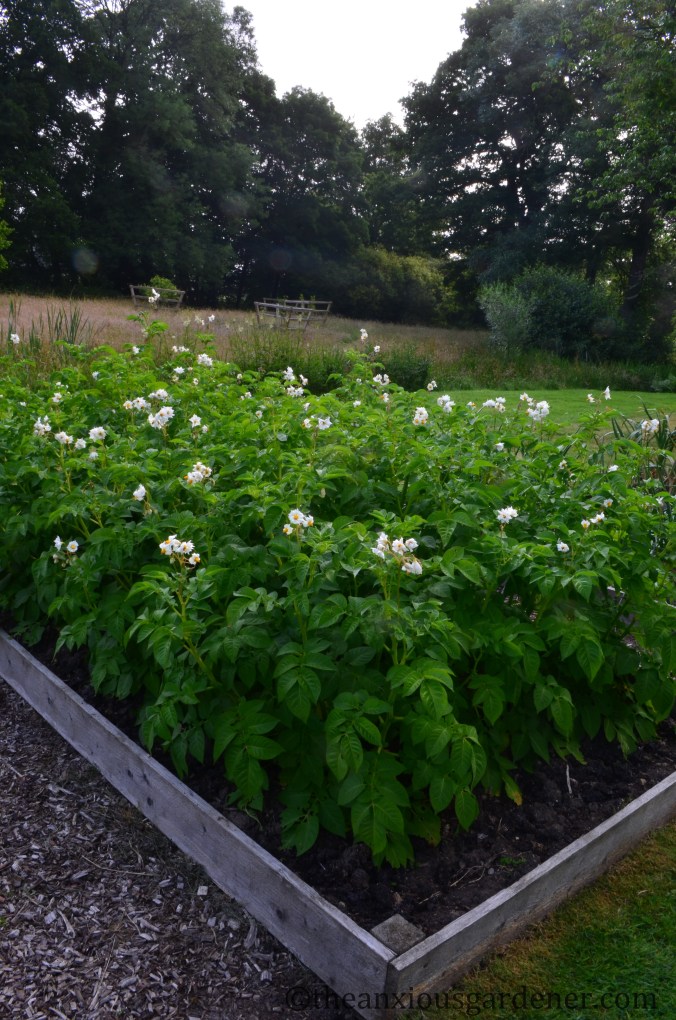


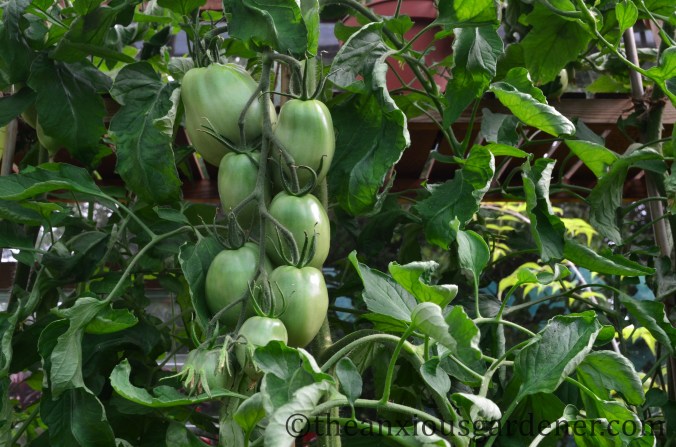
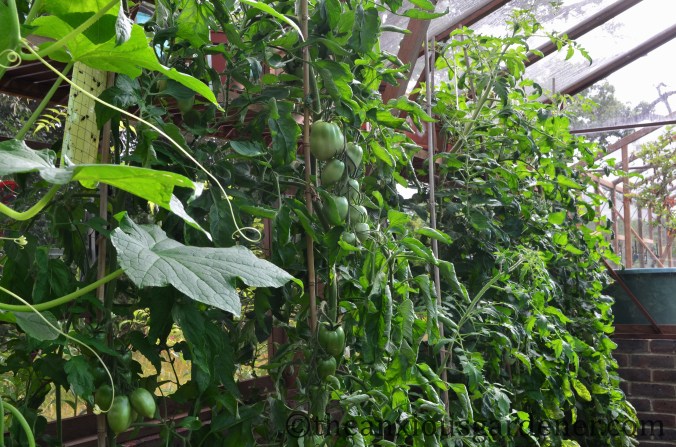
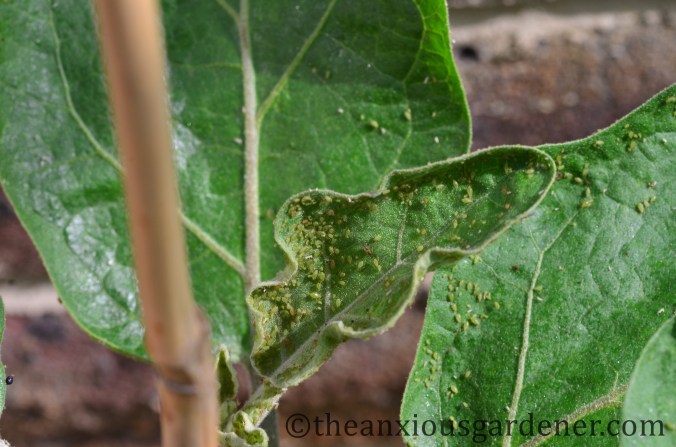




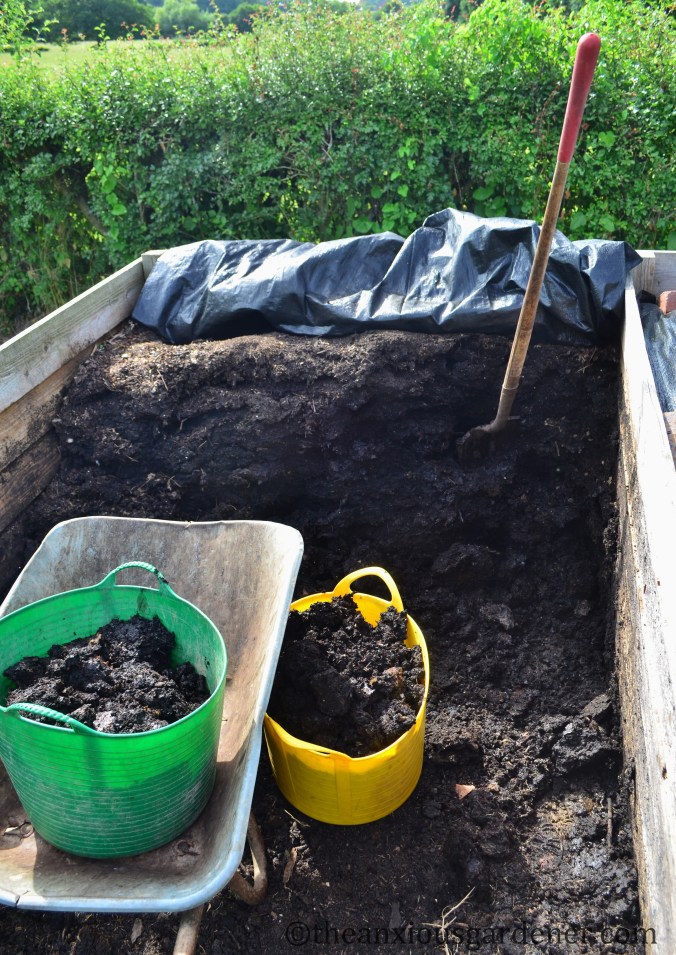

The whole place is looking just brill. Love that white rambling rose. Nice to see that Ligularia…I’ve just bought the same one for my garden.
LikeLike
Thanks Bridget. The ligularia is lovely though I need to keep it watered during dry spells. D
LikeLike
I do love your hedges, the arches are wonderful, but I am so very glad I don’t have to cut anything that ginormous, and in high summer too! The campanula is stunning, I don’t think I have ever seen one that tall, I assume you have to stake it? Three cheers for the ladybird and her larvae, and I am sure that the yellow rattle will do its job and the meadow will gain more flowers year on year. From what I have read it takes several years to start establishing well, unlike the “instant” meadows one reads about in magazines. Love the knautia photo, I think it is my favourite flower at the moment.
LikeLike
Hi Janet, yes the campanula has to be supported and I’m very keen on knautia too. This is its best year, I think. And thanks for the meadow encouragement – it is a long-term investment and I suppose this is only its fifth year. Certainly knapweed is spreading and the number of butterflies is encouraging even if the number of flower isn’t. D
LikeLike
I don’t miss trimming hedges but I do miss the feeling of satisfaction from having such a big job well done. Your hedges look great and so do the gardens and grounds.
LikeLike
I was thinking that I might pass the job to contractors next year, Allen – it is such hard work. But I think I’ll stick at it for a while yet. It is nice to be in control and, like you say, the satisfaction is a payback. D
LikeLike
I’ve just discovered your blog and goodness, what a lovely garden! Don’t envy you the beech hedge cutting on the hottest day of the year but you’ve done a lovely job on it.
LikeLike
Thanks. I didn’t envy me the beech cutting either. D
LikeLike
I’m glad to see you get some real summer, David – it doesn’t happen too often, does it? Whatever your self-doubt, all of it looks surprisingly alive to me, and beautifully composed.
LikeLike
Hi Mr F, yes having a proper summer has been somewhat of a shock though the hot, dry spell is over for now. D
LikeLike
As always a delightful and inspirational blog – I’m going straight outside to cut back my centaurea, alchemilla and hardy geraniums. Your borders are so lush and your hedge trimming skills second to none! Well done in all this heat.
LikeLike
I always worry when anyone does as I suggest, Alison. If the plants which I’ve cut back at the Priory don’t come back I shan’t worry too much – I just very much hope yours do! Thanks for your kind words. Dave
LikeLike
The garden look stunning. All that hedge trimming, wow. I’ve only got a few box balls and 2 yew pyramids to do but I’m not really looking forward to that. 😉 Ladybirds have been sorely lacking here, aphids on the other hand have been in plague like proportions on my newly planted ornamental hops. A couple ladybirds have appeared in recent weeks but not in great quantities which is sad. The problem with being on an allotment is not everyone is organic and some are a bit trigger happy with the chemical sprays.
LikeLike
I now have a clutch of adult ladybirds in the greenhouse, WW – I didn’t realise they became adult so quickly. And I have seen a few more outside but no, not many. When I worked at the nursery one of my colleagues walked past with an insecticide. Going to investigate I managed to stop her from spraying ladybird larvae! D
LikeLike
what a wonderful garden !!!!
LikeLike
Thank you Gwennie. Though I often want to scream at it (and sometimes do) I love it very much. D
LikeLike
I can understand you some times want to scream, that garden is HUGE !
LikeLike
In the Priory gardens, no-one can hear you scream. D
LikeLike
then you can scream all your frustrations away at all times !
it must be wonderfully quiet there, lovely !! only the sound of the birds and the wind in the tree’s, paradise !!!!
LikeLike
it looks so lush despite the weather. I wont post a picture of my beech hedge as you will be tutting about my terrible hedge cutting skills – wonky and bits missed! I havent seen many ladybirds at all this year
LikeLike
I wouldn’t tut Helen – I’ve cut enough hedges now to know how difficult it is. I was faffing about with those arches much longer than any competent hedge cutter would have. And no – virtually no ladybirds and I haven’t seen any since I released this one into the greenhouse. Puzzling, as we have plenty of butterflies and honey bees too this year. Dave
LikeLike
Maybe you keep the echinops because the bees love it so
LikeLike
Hi Ros, yes indeed and the globes are very pretty too. Its root-ball is enormous but I might try splitting it this autumn and putting a couple in the long borders – it’s out of scale in the kidney beds. But that would require me to be decisive – tricky. Dx
LikeLike
That’s an enormous echinops indeed!
How brilliant that the ladybirds solved your aphid problems with no fuss – I love it when nature comes through!
Your newly cut hedges look wonderfully crisp, well worth the pain!
Sara
LikeLike
Thanks Sara. The echinops does fascinate me. It needs support as it is so tall (much taller than me) and was given to me by a friend 3 or 4 years ago when I was desperate for plants just to fill gaps in the borders. I think partly I am a little in awe of it but its job is done so probably time for a re-think. Dave
LikeLike
Everything is looking very full so you must be giving huge quantities of water or is your soil clay and holding on to all the water you had for the past year! I am very aware that my garden has so many more flowers this year with the spring into summer rain we’ve had. But now it is hot, high 30’s and no more storms, but it can’t last long……..can it?
LikeLike
Hi Christina, the soil is clay but certainly isn’t holding onto any moisture. It is baked hard with big, big cracks appearing – in places I can insert my hand into them! So yes – lots and lots of watering. Our hot spell has broken now – it’s been so nice having a proper summer but gosh, it has been hard work. Weather for sitting by a pool with a cold beer rather than gardening. Dave
LikeLike
Your posts are always a delight ! Honest ! Tell me tell me tell me … how do you make an arch in a hedge please ??? I have 2 overgrown beech waving about on either side of a gate, just waiting to be conjoined, but I don’t know how !
LikeLike
Hi, well you’ll need to build a frame. If you look at the second photo, you’ll see there is an old gate frame that I’m using (I’ll left this behind for the purpose when I removed an ugly old trellis fence) and I tie in the long whippy top beech growth down on to this. In the fourth photo, I’ve simply inserted a hazel pole across the gate to tie in some growth – but I shall need to add a couple more. A few inches of snow and it’ll collapse. The older arches have the original supports still within them but they don’t do much in the way of support anymore – the thick branches of the beech do this. So it sounds like all you’ll need is two posts and a top brace and then bend and tie in the top growth from your two wavy plants. Hope that helps – oh and a dollop of patience helps too. Always very relieved to hear if anyone likes my blog – so thank you very much. Dave
LikeLike
How stalwart you are tackling the hedge in this heat, rather you than me as they say. The garden is looking lovely and is a credit to your skill in providing July colour.
LikeLike
Thanks Elaine. A nice, cool, cloudy day would have been good – but that hasn’t happened yet on beech-hedge cutting day. It is the hardest work-day of the year and one to knuckle down to and endure. Dave
LikeLike
I know the yucca aren’t your favorites, but wow — they look spectacular! They are treated so differently here — generally isolated or maybe with low grasses and groundcovers in native/desert-type landscaping. I don’t know that I’ve ever seen them integrated into a bed before, let alone a lush, gorgeous one like that. (Not that we do lush in general.) Good motivation to keep your body armor/face visor in tip-top condition.
LikeLike
Hi Stacy, no – I don’t think I’ve seen them in borders like this before. I would much prefer that they were free standing and out of the long borders but hey, ho someone obviously thought they would work. (I would so love to have access to old pictures/planting records and be able to see how the gardens were planned and have evolved). I have come very close to poking my eye on those vicious leaf spikes and am now very wary of them. Dave
LikeLike
Lots of stuff to envy there – how neat it all looks, and how well you have kept the colour going. I’ve never pretended to have anything other than a June garden, so by late July, it’s just a ruin! And I look at your hedge cutting and despair, because I haven’t started mine… That blue clematis Wisley by the white rose – Is the colour accurate? If so, I need to have it!
I assume, from the lack of p.florindae pictures that you need some more seed? I also think you need to put some serious thought into that pond – it could be really lovely.
LikeLike
Hi Mr K, yes I believe the ‘Wisley’ colour is pretty accurate – it is described as a violet blue. If you look at online pictures some are more violet but mine is blue. What I call the rock border is a May/June border and is over now (which is why it doesn’t feature in this post). I do have a couple of florindae plants thanks but they haven’t flowered yet – next year! I dip into Beth Chatto’s ‘The Damp Garden’ often for inspiration and I do intend to plant more pond-side plants but they must be tough to compete with the rough stuff – I haven’t the time to mollycoddle them. Also, I’ve been quite busy enough getting the beds and borders, meadow and hedges to a reasonable state after their years of neglect. I’m hoping that as the garden becomes more established I shall have time for new projects and more waterside planting would be one of them. But I have planted a Darmera peltata for example and it happily competes with long grass, dock and nettles. I thought I might see whether ligularia will be happy in such an environment too. Dave
LikeLike
The big ligularia compete well (provided the slugs don’t massacre them). Especially l. veitchiana. About do a post on big plants…
LikeLike
Sounds like a contender, Mr K – thanks. And I’ve been studying Wisley and I’m going to back-peddle. It is bluish! D
LikeLike
What a beautiful job you did trimming that hedge. I started a hedge from scratch 4 years ago (native thuya). Most of it has reached the desired height and it filled out nicely but my pruning is slightly wavy. I hope that, with experience, my pruning will improve.
LikeLike
It does improve, Alain. I think we did the best job yet on the beech hedging this year. I used to have contractors cut it but I prefer to keep it ‘in house’ as it gives me more control and after our third year we are better at it. (The yew I cut is quite wavy in places – I shall need to re-visit it). Dave
LikeLike